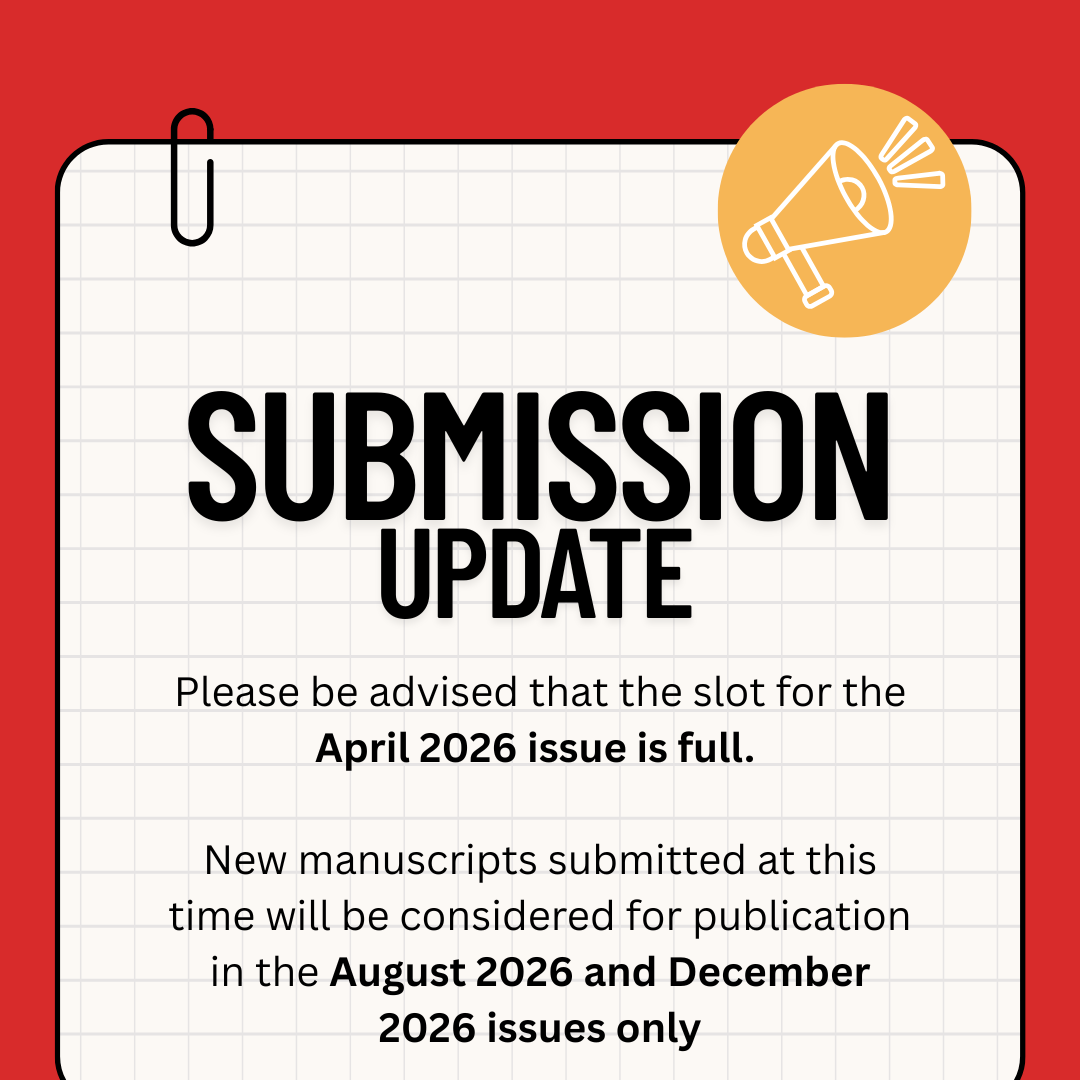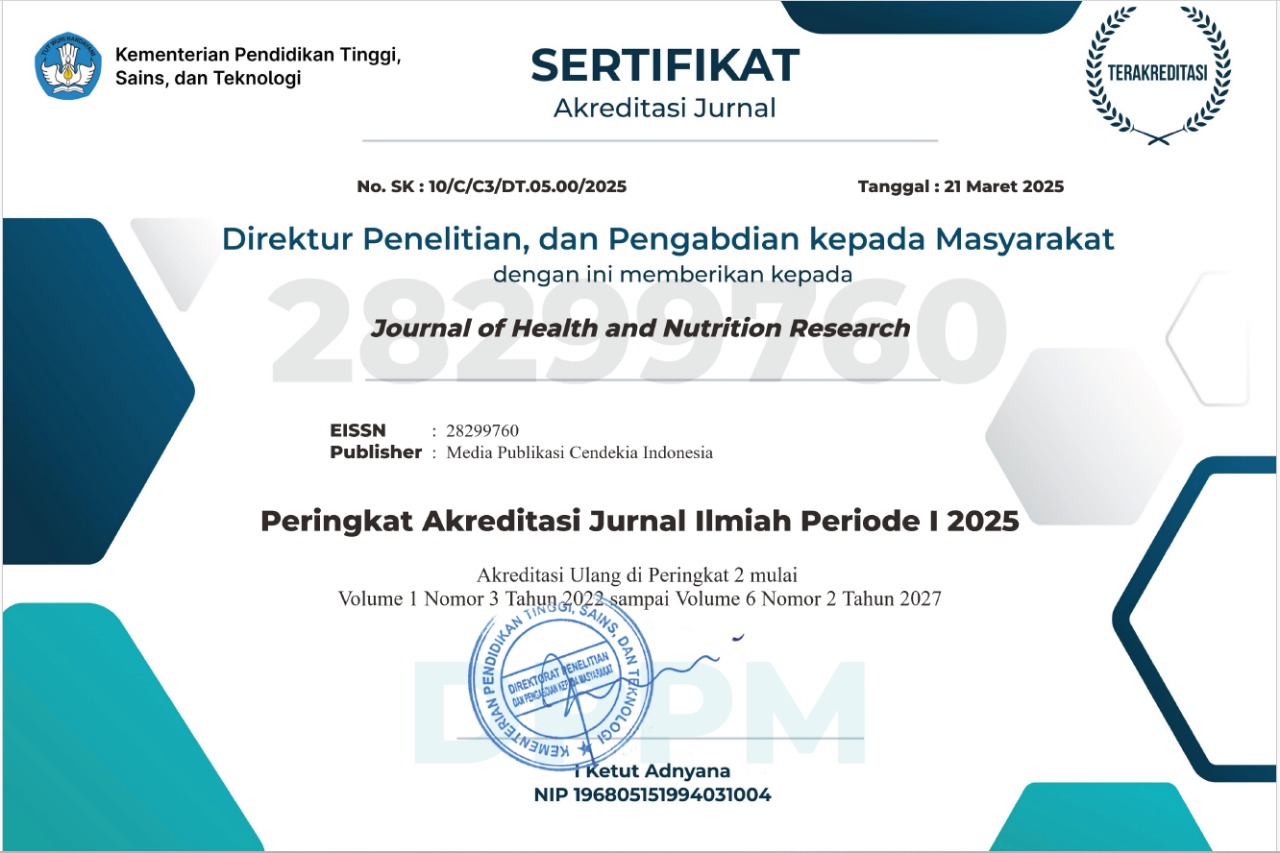The Relationship Between Early Pregnancy, Birth Distance, and Resident Status with Stunting Incidence in Elementary School Children In Enrekang Rural
Keywords:
Stunting, School Children, Early Pregnancy, Birth Spacing, Residence StatusAbstract
This study aims to determine the relationship between maternal age at first pregnancy, birth spacing, and residence status with the incidence of stunting in elementary school children in rural Enrekang. A community-based cross-sectional study was conducted in 3 villages in Enrekang Regency. This study involved 100 elementary school children who were selected by purposive sampling. Data was collected using a validated structured questionnaire and microtia. These results are then processed to obtain the child's nutritional status using the WHO Anthro-Plus software, namely Z-score the Height/Age index. The statistical test used is the Chi-square test. From a total of 100 children as respondents, 72.0% were found to be stunted and 28.0% were found to be normal. The age of the mother during pregnancy is considered ideal at 62.0%, the ideal birth spacing for children is 84.0%, and the status of residence with own ownership is 67.0%. The results showed that there was no significant relationship between the mother's age at first pregnancy (p=0.693) and birth spacing (p=0.373) and the incidence of stunting. Meanwhile, the status of residence is considered related to the incidence of stunting in elementary school children with a value of p = 0.014. Maternal age at first pregnancy and birth spacing were not related to stunting. We suspect parenting style, the mother's attitude, sanitation hygiene, environmental cleanliness, and housing conditions indirectly contribute to the incidence of stunting. It is hoped that further research examines this matter.
Downloads
References
Berhanu A, Garoma S, Arero G, Mosisa G. Stunting and associated factors among school-age children (5–14 years) in Mulo district, Oromia region, Ethiopia. SAGE Open Medicine. 2022;10.
Danso F, Appiah MA. Prevalence and associated factors influencing stunting and wasting among children aged 1 to 5 years in Nkwanta South Municipality, Ghana. Nutrition. 2023;110:111996.
Menteri Kesehatan Republik Indonesia. Standar Antropometri Anak. Vol. 21, Malaysian Palm Oil Council (MPOC). 2020. 1–9 p.
Berawi KN, Puspaningrum DA, Bakri S, Zuraida R, Kurniawaty E, Yanfika H. The Effect of Sanitation Performance and Parental Livelihood on Stunting Severity: Study at 3 Ecological Zones at South Lampung Regency, Indonesia. Universal Journal of Public Health. 2023;11(1):155–69.
Wati EK, Wahyurin IS, Sari HP, Zaki I, Dardjito E. Stunting Incidence in Infant Related to Mother’s History During Pregnancy. Kemas. 2022;17(4):535–41.
Balitbangkes RI. Laporan Riskesdas 2018 Nasional.pdf. Lembaga Penerbit Balitbangkes. 2018.
Litbang P, Kesehatan U, Penelitian B, Pengembangan dan, Ri KK. Studi Status Gizi Balita Di Indonesia Tahun 2019. 2019;
Kemenkes RI 2021. Survei Status Gizi Indonesia. News.Ge. 2021. https://news.ge/anakliis-porti-aris-qveynis-momava.
Laksono AD, Sukoco NEW, Rachmawati T, Wulandari RD. Factors Related to Stunting Incidence in Toddlers with Working Mothers in Indonesia. International Journal of Environmental Research and Public Health. 2022;19(17).
Ponum M, Khan S, Hasan O, Mahmood MT, Abbas A, Iftikhar M, et al. Stunting diagnostic and awareness: Impact assessment study of sociodemographic factors of stunting among school-going children of Pakistan. BMC Pediatrics. 2020;20(1):1–9.
Sathiadas G, Annieston A, Arunath V, Kasthuri T, Wickramasinghe VP. Nutritional status of school children living in Northern part of Sri Lanka. 2020;4–11.
Abdulla F, Rahman A, Hossain MM. Prevalence and risk predictors of childhood stunting in Bangladesh. PLoS ONE. 2023;18(1 January):1–20.
Metwally AM, El-Sonbaty MM, El Etreby LA, El-Din EMS, Hamid NA, Hussien HA, et al. Stunting and its determinants among governmental primary school children in Egypt: A school-based cross-sectional study. Open Access Macedonian Journal of Medical Sciences. 2020;8(B):650–7.
Sisay M, Atenafu A, Hunegnaw MT, Lorato MM. Prevalence and factors associated with stunting and thinness among school age children in rural primary schools, East Dembia District, Northwest Ethiopia. BMC Nutrition. 2022;8(1):1–10.
Beal T, Tumilowicz A, Sutrisna A, Izwardy D, Neufeld LM. A review of child stunting determinants in Indonesia. Maternal and Child Nutrition. 2018;14(4):1–10.
Lisanu Mazengia A, Andargie Biks G. Predictors of stunting among school-age children in Northwestern Ethiopia. Journal of Nutrition and Metabolism. 2018;2018.
Mediani HS. Predictors of Stunting Among Children Under Five Year of Age in Indonesia: A Scoping Review. Global Journal of Health Science. 2020;12(8):83.
Torlesse H, Cronin AA, Sebayang SK, Nandy R. Determinants of stunting in Indonesian children: Evidence from a cross-sectional survey indicate a prominent role for the water, sanitation and hygiene sector in stunting reduction. BMC Public Health. 2016;16(1):1–11.
Ryadinency R, N S, Patmawati TA. Analysis of Determinant Factors in Stunting Children in Palopo, Indonesia. Journal Wetenskap Health. 2020;1(2):77–82.
Prendergast AJ, Humphrey JH. The stunting syndrome in developing countries. Paediatrics and International Child Health. 2014;34(4):250–65.
Abri N. Identification of Socio-Demographic Factors with the Incidence of Stunting in Elementary School Children in Rural Enrekang. Journal of Health and Nutrition Research. 2022;1(2):88–94.
Simanjuntak BY, Haya M, Suryani D, Khomsan A, Ahmad CA. Maternal Knowledge , Attitude , and Practices about Traditional Food Feeding with Stunting and Wasting of Toddlers in Farmer Families. 2019;14(2):58–64.
Sani M, Solehati T, Hendarwati S. Hubungan usia ibu saat hamil dengan stunted pada balita 24-59 bulan. Holistik Jurnal Kesehatan. 2020;13(4):284–91.
Simbolon D, Jumiyati J, Ningsih L, Riastuti F. Is there a Relationship Between Pregnant Women’s Characteristics and Stunting Incidence In Indonesia? Jurnal Kesehatan Masyarakat. 2021;16(3):331–9.
Atamou L, Rahmadiyah DC, Hassan H, Setiawan A. Analysis of the Determinants of Stunting among Children Aged below Five Years in Stunting Locus Villages in Indonesia. Healthcare. 2023;11(6):810.
Afeworki R, Smits J, Tolboom J, Van Ven A Der. Positive effect of large birth intervals on early childhood hemoglobin levels in africa is limited to girls: Cross-sectional DHS study. PLoS ONE. 2015;10(6):1–14.
Wang L, Van De Gaar VM, Jansen W, Mieloo CL, Van Grieken A, Raat H. Feeding styles, parenting styles and snacking behaviour in children attending primary schools in multiethnic neighbourhoods: A cross-sectional study. BMJ Open. 2017;7(7):1–10.
Abri N, Sirajuddin S, Bahar B, Jafar N, Russeng SS, Zakaria Z, et al. Determinants of Incident Stunting in Elementary School Children in Endemic Area Iodine Deficiency Disorders Enrekang Regency. Open Access Macedonian Journal of Medical Sciences. 2022;10:161–7.
Das M, Jana A, Muhammad T. Understanding the associations between maternal high-risk fertility behaviour and child nutrition levels in India: evidence from the National Family Health Survey 2015–2016. Scientific Reports. 2022;12(1):1–15.
Abri N, Thaha AR, Jafar N. Relationship Between Economic Status, Infectious Diseases and Urinary Iodine Excretion with Stunting Incidence of Elementary School Children in IDD Endemic Areas, Enrekang Regency. Journal of Health and Nutrition Research. 2022;1(3):133–9.
Permatasari TAE, Chairunnisa C, Djarir H, Herlina L, Fauziah M, Andriyani A, et al. The Determinants of Stunting in the Under-five in Three Municipalities in the Special Capital Region of Jakarta. Kesmas: Jurnal Kesehatan Masyarakat Nasional. 2023;18(1):32.
Published
How to Cite
Issue
Section
Copyright (c) 2023 Nur Abri, Nur Zakiah, Alya Fajrani Risal

This work is licensed under a Creative Commons Attribution-NonCommercial-ShareAlike 4.0 International License.
Most read articles by the same author(s)
- Sitti Zakiah, Aminah Toaha, Nur Abri, Endah Wahyutri, The Effect of Nutrition Education on Knowledge, Attitudes, and Iron Intake in Adolescent Girls , Journal of Health and Nutrition Research: Vol. 2 No. 3 (2023)
- Nur Abri, Identification of Socio-Demographic Factors with the Incidence of Stunting in Elementary School Children in Rural Enrekang , Journal of Health and Nutrition Research: Vol. 1 No. 2 (2022)
- Saibatul Hairiyah, Aminah Toaha, Nur Abri, Dini Indo Virawati, The Effect of SEKAR (Sumber Edukasi Anemia yang Relevan) Card-Based Nutrition Education on Knowledge and Iron Intake in Pregnant Women , Journal of Health and Nutrition Research: Vol. 2 No. 3 (2023)
- Nur Abri, Abdul Razak Thaha, Nurhaedar Jafar, Relationship Between Economic Status, Infectious Diseases and Urinary Iodine Excretion with Stunting Incidence of Elementary School Children in IDD Endemic Areas, Enrekang Regency , Journal of Health and Nutrition Research: Vol. 1 No. 3 (2022)



















